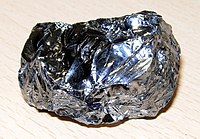
Photo from wikipedia
The wooden sluice site of the Nanyue Kingdom in Guangzhou, China, is covered with white magnesium sulfate salt whiskers continuously growing from the surface. In this paper, polarizing microscopy, scanning… Click to show full abstract
The wooden sluice site of the Nanyue Kingdom in Guangzhou, China, is covered with white magnesium sulfate salt whiskers continuously growing from the surface. In this paper, polarizing microscopy, scanning electron microscopy, infrared thermography, Fourier transform infrared spectrometry, and surface tension analysis were utilized to comprehensively analyze the micromorphology of whiskers grown on the surfaces of porous materials collected at the site of Nanyue Kingdom, as well as the change laws of magnesium sulfate solution droplets on the porous hydrophilic matrix, and the migration and crystallization of magnesium sulfate solution in the capillary tube. The diameters of magnesium sulfate salt whiskers grown on the surfaces of porous samples range from 30 to 110 μm. For the first time, it is clear to see that the whisker’s structure is hollow and nodular. There are solid crystalline salts in hollow tubes, and some of them are aqueous. The top sections of whiskers are approximately circular and are composed of particles with a size of about 0.4–4.0 μm. Their growth conditions are mainly characterized by the high humidity environment where the porous material is located or locally located, the formation of an annular whisker base, and the pressure difference generated during the formation progress of water-bearing crystals in the capillary of the whisker. The research results expound on the circumstances and mechanism of magnesium sulfate solution-induced whisker development on the surface of porous materials, providing a reference for the study of the whisker growth mechanism.
Journal Title: ACS Omega
Year Published: 2023
Link to full text (if available)
Share on Social Media: Sign Up to like & get
recommendations!